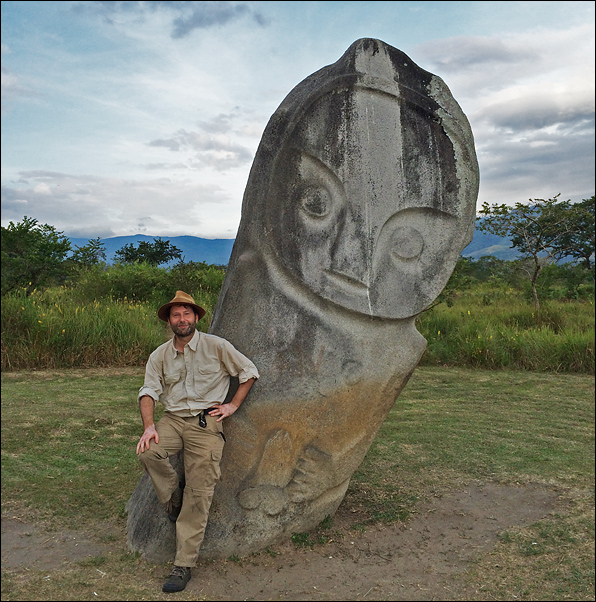

I am active as a scientist in a number of different fields. I am a Palaeolithic archeologist by training, but currently academically work in a different discipline: Space Situational Awareness (SSA) and Space Surveillance and Tracking (SST). I also research meteorites and discovered asteroids. I am an expert on tracking classified (military) satellites.

I have previously worked as an academic researcher at Leiden University, the VU University Amsterdam and at Naturalis Biodiversity Center (the Dutch National Museum of Natural History). I have worked for three Municipal archaeology/heritage departments. I am currently employed at Delft Technical University, as a Lecturer in 'optical Space Situational Awareness' in the Astrodynamics and Space Missions section of the Faculty of Aerospace Engineering.
Archaeology - From 1991 to 1998, I studied pre- and protohistory at Leiden University, with a focus on the archaeology of the Lower and Middle Palaeolithic. In 2003, I obtained my PhD at the Leiden Faculty of Archaeology.
After obtaining my MA degree cum laude in 1998 and receiving the national W.A. van Es Prize of the Foundation for Dutch Archaeology for my MA thesis, I briefly worked as a field archaeologist at BOOR, the Municipal archaeological service of Rotterdam. I would briefly work there again in 2002-2003. From mid-2018 to mid-2020, I work part-time for Erfgoed Leiden en Omstreken (Leiden Heritage, the Leiden Municipality Heritage department), creating GIS data.
In November of 1999, I started a fast-track PhD of 2.5 years (instead of the regular 4 years for Dutch PhD's) at Leiden University, Faculty of Archaeology, with Prof. dr. Wil Roebroeks. Initially there was money for only one year: the Dutch National Science Foundation NWO then financed an additional 1.5 years. I finished my dissertation late 2002 and obtained my PhD in 2003.
Dissertation - The resulting dissertation, "Out of Africa", an investigation into the Earliest Occupation of the Old World appeared with Archaeopress in Oxford in 2004 as BAR International Series nr. 1244. It is a study of the chronology and circumstances of the first colonization of Eurasia by hominins from Africa, between 2 and 1 million years ago, putting behavioural changes and chronological patterns in a climatological background. One of the main conclusions is that an adaptation to the rise of increasingly seasonal environments in Plio-Pleistocene Africa, enabled a dispersal into the seasonal environments of Pleistocene Eurasia.
Colmont field project - With two colleagues (Alexander Verpoorte and Boudewijn Voormolen) I initiated a field project and field school, the 2001 Colmont excavation and survey on the Plateau of Ubachsberg in Dutch Limburg. We excavated a Middle Palaeolithic site on the "clay with flints" on a promontory (the "Vrakelberg") overlooking a prominent dry valley, and surveyed the surrounding plateau.
NWO VENI grant - In 2007, I was awarded a VENI grant for young scientific talent by the Dutch National Science Foundation NWO. From March 2008 to March 2012, this grant allowed me to work as a post-doc at the Institute for Geo- and Bioarchaeology (IGBA) at the faculty of Earth and Life Sciences of the VU University Amsterdam. Between March 2012 and early 2014, I was a guest researcher at the same research institute (which sadly was closed down in 2014).
My research during this period focussed on the spatial behaviour and cognition of Neandertals. I published a critical and well-cited paper in Quaternary International in 2012, in which I pointed out the flawed way in which archaeologists and palaeoanthropologists approach the evolution of cognition in early humans. The typical model employed is not a branched tree model but a strongly outdated, and in fact pre-Darwinian linear model. It results from a heuristic framework which puts "Modern humans" and primates as opposites on an ascending line of cognitive complexity.
In my paper I argued for the non-relevance and inappropriateness of using "modern behaviour" as a yardstick for cognitive sophistication (the flawed superior-inferior paradigm). One important message I tried to convey in my paper, is that we should realize the possible existence and importance of unique cognitive skills (and unique behaviours) in non-modern human ancestors, behaviours and skills that are not known from modern humans and extant primates. It are these unique skills and behaviours that define these hominins. But by their very nature they are also very difficult to discern in the archaeological record. As part of the attached case study I presented a novel mobility model, 'itinerary foraging', for Middle Pleistocene Eurasian hominins (Neandertals and their direct ancestors), illustrated by the chaine operatoire of biface production in Boxgrove and Levallois products in the Meuse valley.
My research increasingly incorporates palaeoneurological elements, encouraged to do so by Emiliano Bruner, who in 2014 invited me to contribute a paper to "Three hands for the Neanderthal lineage", a special Forum issue of the Journal of Anthropological Sciences. This (I admit) highly experimental explorative paper, "Ice age Mentalists", was an exercise in finding novel ways to look at the evolution of cognition, and honour unique cognitive skills of extinct hominins (particularly those of Neandertals).
Teaching - Both while a PhD student at Leiden University and during my post-doc at the VU University Amsterdam, I enjoyed teaching Batchelor and Master level students. I have given topical workshops, and teached classes on (amongst others) methods and techniques in Palaeolithic archaeology, Neandertals and the relationship between climate change and Human evolution. Currently, I am a lecturer at the Aerospace Engineering faculty of Delft Technical University, on Space Situational Awareness.
Meteoritics - Archaeology is not the only science I am active in. Over the years I have published several peer-reviewed astronomical papers on meteors and I have participated in a number of scientific observational expeditions, amongst others to Northwest China in 1998, Arizona in the USA in 2001, and southern Europe in various years.
I have a long standing interest in meteorites. From 2012 to 2019 (when our publication in Meteoritics and Planetary Science appeared), I was one of the primary investigators of the Diepenveen meteorite, a rare and anomalous CM meteorite that fell in the Netherlands in 1873 but was unknown untill it surfaced in 2012. In 2017, I became part of the investigation of the newest Dutch meteorite, Broek in Waterland (L6 chondrite: an observed fall on 11 January 2017) as well. In 2015 and 2017, I was hired as a researcher at Naturalis Biodiversity Center (the Dutch National Museum of Natural History in Leiden) for continued research on these meteorites.
Asteroids - I have discovered several asteroids, including two small Near Earth Asteroids, 2005 GG81 and 2015 CA40. The latter Near Earth Asteroid approached to within 6.3 Lunar distances in February 2015. I have been a volunteer plate reviewer in the Spacewatch FMO project, and in the Hungaria-based Szeged Asteroid Survey. In 2008, the International Astronomical Union (IAU) named an asteroid after me, asteroid (183294) Langbroek.
Satellites - I am a satellite tracker, part of a small informal international team that tracks classified military satellites ("spy satellites"). In 2016, I was asked to brief Members of Parliament on military satellite systems during a hearing of the Permanent Foreign Affairs Committee of Dutch Parliament related to the shootdown of flight MH17. Shortly after this, I was approached by the Space Security Center of the Royal Dutch Air Force for consultancy on satellite tracking related issues. I consider my work on satellites to be a form of "Space Archaeology". I publish a dedicated blog with observations, news, thoughts and analysis relating to military space programs. In 2017, and from mid-2019 to mid-2022, I worked at Leiden Observatory (the Leiden University astronomy dept.) in the FOTOS 1 and 2 SSA projects commissioned by the RNLAF. Since June 2022 I work at Delft Technical University, as a Lecturer in 'optical Space Situational Awareness' in the Astrodynamics and Space Missions section of the Faculty of Aerospace Engineering.
Other - In 2012, the Royal Dutch Association for Astronomy and Meteorology (KNVWS) awarded me their Dr J. van der Bilt Prize for my work on meteors and asteroids. My activities in the fields of archaeology, asteroids, meteorites and satellites have also resulted in several appearances on national radio and TV.
My varied interests have sometimes cross-fertilized each other. In 2000 I published a paper in the Journal of Human Evolution discussing the relevance of the co-occurence of tektites, a form of impact glass created by large asteroid impacts, and Homo erectus fossils in Java for the age of the latter. In 2015, I published another paper in the Journal of Human Evolution involving tektites, this time questioning purported 800 Ka ages assigned to bifacial stone tools in southern China. An appendix to my 2003 PhD dissertation delves into the significance of the Australasian impact 0.8 Ma ago for hominin evolution in SE Asia.
I have travelled extensively, sometimes "off the beaten path", to places that vary from (to name a few) Laos and central Borneo to the central highlands of West New Guinea. Nature, wildlife, megaliths and rock art are typical elements of my travels.
Some of my other interests and activities include rowing, Odonata (Dragonflies and Damselflies), photography, geology, (neuro-) psychology, ethnography (particularly on New Guinea), palaeoclimatology, military history, Space history and historic aircraft. I am a rowing instructor at the rowing association RV Rijnland.